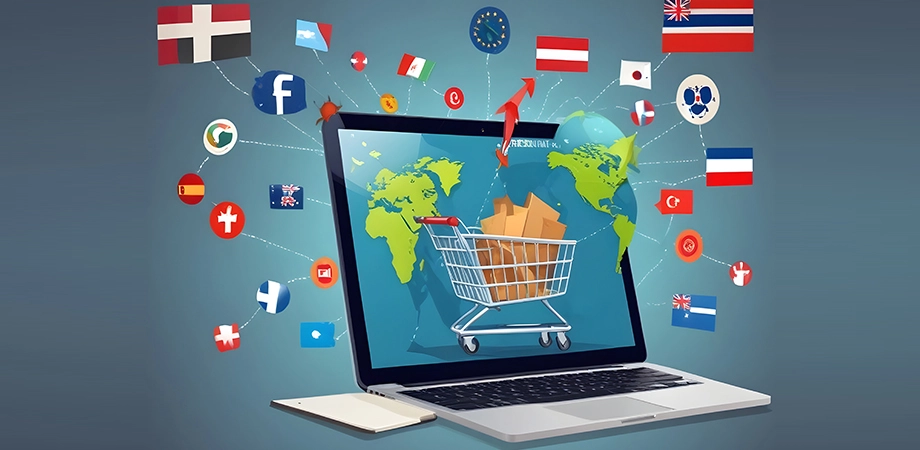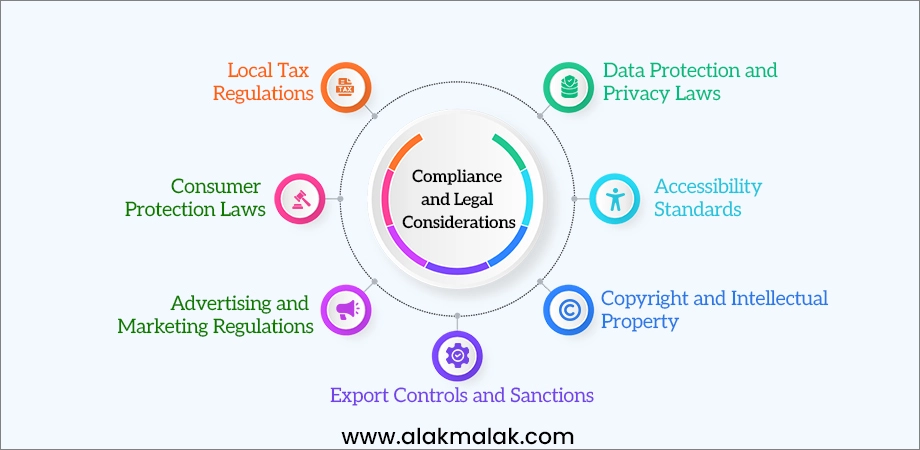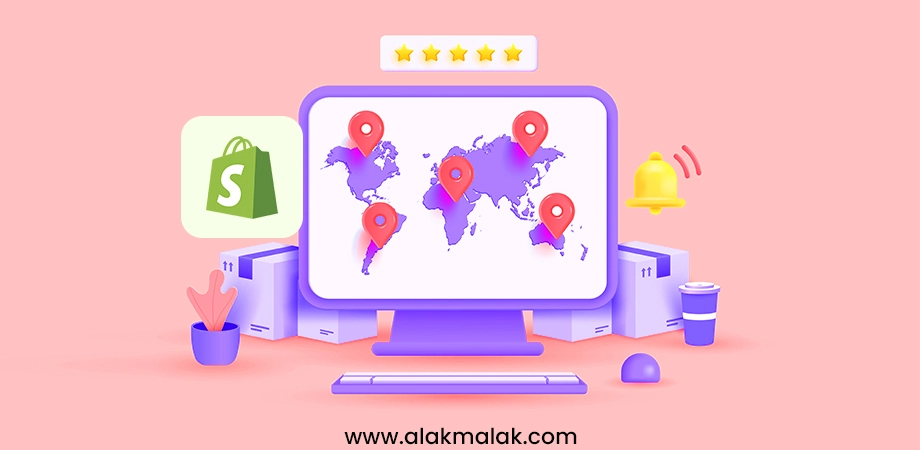Are you an ecommerce entrepreneur feeling stuck in your home market, yearning to expand your reach and tap into the global customer base? If so, you’re not alone. In today’s digital landscape, the opportunities for ecommerce businesses to go global have never been greater.
However, the path to international expansion can feel daunting, with complex logistics, cultural nuances, and regulatory hurdles to navigate. As the founder of a successful eCommerce web development agency with over 18 years of experience helping businesses scale internationally, we’re here to tell you that growing your online store globally is absolutely achievable.
In this blog post, we’ll share our top tips and strategies to help you grow eCommerce business internationally. From optimizing your website for international audiences to streamlining your fulfillment and logistics, you’ll learn everything you need to know to expand your customer base, boost your revenue, and stay ahead of the competition. Let’s dive in!
Tips To Grow eCommerce Business Internationally
Here is the list of things you must consider to grow your eCommerce business internationally:-
1. Perform Comprehensive Market Analysis
Before you take your ecommerce business global, it’s critical to conduct comprehensive market research to understand the unique needs, preferences, and behaviors of potential customers in your target international markets. Skipping this crucial step is a recipe for costly mistakes and lost opportunities.
Why is market research so important for growing your ecommerce business internationally?
According to a study by Forrester Research, companies that invest in customer insights and market intelligence are 2.2 times more likely to outperform their competitors. When you deeply understand your international audience, you can create a tailored customer experience that resonates and drives sales.
Where do you start?
Here are some key steps to implement thorough market research for international ecommerce expansion:
1. Analyze market demographics and psychographics: Gather data on the age, gender, income level, interests, pain points, and buying behaviors of consumers in your target markets. This will help you create buyer personas and customize your product offering, marketing, and user experience.
2. Research local competition: Conduct a competitive analysis to understand what other ecommerce businesses are doing in your target markets. Identify their strengths, weaknesses, and opportunities you can capitalize on.
3. Evaluate logistics and regulations: Investigate the shipping, taxation, and compliance requirements for doing business in each market. This will inform your pricing, fulfillment strategies, and overall operational planning.
4. Test and validate your assumptions: Don’t rely solely on secondary research. Conduct customer surveys, focus groups, and A/B testing to get direct feedback from your intended international audience.
2. Develop a Global-Friendly Website
Once you’ve completed your market research and gained a thorough understanding of your target international customers, it’s crucial to collaborate with a website development company to optimize your ecommerce website for a global audience. Your website serves as the digital storefront for your business, and crafting a seamless, localized experience is essential for converting visitors into paying customers. By partnering with a website development company, you can ensure that your site is tailored to meet the specific needs and preferences of diverse audiences around the world, ultimately driving greater engagement and sales.
Why is having a global-friendly website so important?
Studies show that 72% of consumers are more likely to purchase from a site if it’s in their native language. And 73% of consumers say they prefer to buy products with information in their own language. Failing to cater to international audiences can result in high bounce rates, abandoned shopping carts, and lost revenue.
How can you build an ecommerce website that resonates with customers around the world?
Here are some key steps:
1. Implement multilingual and multicurrency capabilities: Ensure your website can display content in multiple languages and accept payments in local currencies. This removes language and financial barriers for international shoppers.
2. Optimize for mobile responsiveness: Given the growing dominance of mobile commerce, your website must provide an exceptional user experience on smartphones and tablets. Ensure fast load times, intuitive navigation, and a streamlined checkout process.
3. Localize your content and design: Tailor your product descriptions, marketing copy, images, and overall aesthetic to reflect the cultural nuances and preferences of each target market. This level of personalization builds trust and affinity with your brand.
4. Improve site speed and stability: International customers expect the same fast, reliable performance as domestic users. Invest in a content delivery network (CDN) and robust hosting infrastructure to maintain optimal site speed and uptime.
3. Compliance and Legal Considerations
As you expand your ecommerce business globally, it’s crucial to ensure you’re operating in full compliance with the laws and regulations of each target market. Overlooking compliance risks can lead to costly fines, legal issues, and damage to your brand reputation.
Why is compliance so important for international ecommerce success?
According to a study by the Harvard Business Review, over 50% of companies that expanded internationally had to withdraw from at least one foreign market due to compliance failures. Navigating the complexities of global trade, taxation, and data privacy can be a minefield for unprepared businesses.
What are the key compliance and legal factors to consider when taking your ecommerce operation global?
Here are some essential steps:
1. Research import/export regulations: Understand the customs, duties, and documentation requirements for shipping your products to each target market. Ensure you have the proper licenses, certifications, and labeling in place.
2. Comply with data privacy laws: From the EU’s GDPR to China’s Cybersecurity Law, familiarize yourself with the data privacy regulations in your target markets and implement the necessary protocols to protect customer information.
3. Establish a local business entity: Consider incorporating a legal business entity within your target markets to streamline operations, simplify tax reporting, and demonstrate your commitment to local customers.
4. Protect your intellectual property: Register your trademarks, copyrights, and other IP assets in each country where you plan to do business to safeguard your brand.
4. Optimizing for International Sales
With your global-friendly website in place and a solid understanding of compliance requirements, the next step is to optimize your ecommerce operations for seamless international sales and fulfillment. Providing a frictionless purchasing experience for customers around the world is key to driving sustainable growth.
Why is sales optimization so crucial for international ecommerce success?
Research shows that 97% of consumers say that convenient delivery options are important when shopping online. Additionally, a study by UPS found that 63% of online shoppers are willing to pay more for a better delivery experience. Failing to meet these heightened expectations can result in abandoned carts, negative reviews, and lost revenue.
How can you optimize your ecommerce business for streamlined international sales?
Consider these strategies:
1. Offer localized payment methods: Provide a variety of payment options that are familiar and trusted in each target market, such as digital wallets, bank transfers, and local credit/debit cards. This reduces friction in the checkout process.
2. Simplify cross-border shipping and logistics: Partner with reliable international shipping carriers that can handle customs clearance, duties, and taxes on your behalf. Provide transparent shipping rates and estimated delivery timelines to set realistic customer expectations.
3. Implement a smooth returns process: Make it easy for international customers to initiate returns and exchanges. Offer prepaid return labels and clear instructions in their native language to maintain a positive brand experience.
4. Monitor and optimize your pricing strategy: Continuously analyze your pricing, taking into account factors like exchange rates, local competition, and customer demand. Adjust your pricing as needed to remain competitive in each market.
5. Building Trust and Brand Awareness
As you venture into new international markets, establishing trust and brand awareness with local customers is critical for driving sales and long-term loyalty. Ecommerce shoppers, especially in unfamiliar regions, want to feel confident that your business is legitimate, reliable, and committed to their needs.
Why is building trust and brand awareness so important for global ecommerce success?
Studies show that 81% of consumers need to trust a brand before making a purchase. And 62% of consumers say they’re likely to be loyal to a brand that resonates with their personal values and beliefs. Failing to cultivate this trust can result in high cart abandonment rates, negative reviews, and an uphill battle against well-established local competitors.
How can you effectively build trust and brand awareness in your target international markets?
Consider these strategies:
1. Partner with local influencers and media: Collaborate with respected figures, bloggers, and publications in each market to increase your credibility and exposure to qualified buyers. Leverage their existing audience and authority to drive brand awareness.
2. Participate in local trade shows and events: Attend or sponsor relevant industry events to connect face-to-face with prospective customers, showcase your products, and demonstrate your commitment to the local community.
3. Localize your content and social media: Tailor your website content, social media posts, and customer communications to reflect the language, customs, and preferences of each target market. This level of personalization builds trust and affinity.
4. Offer exceptional customer support: Provide dedicated, multilingual customer service to swiftly address any questions or concerns from international shoppers. Prompt, empathetic support can turn one-time buyers into loyal brand advocates.
6. Prioritize Mobile-First eCommerce Web Design
As you expand your ecommerce business globally, it’s essential to prioritize a mobile-first approach to your website and digital marketing strategies. In today’s hyper-connected world, the majority of online shopping activity is happening on smartphones and tablets, particularly in emerging markets where mobile devices may be the primary – or even sole – means of internet access.
Why is a mobile-first mindset so critical for international ecommerce success?
Consider these compelling statistics:
- Over 70% of global internet traffic now comes from mobile devices
- Mobile commerce accounts for 72.9% of all ecommerce sales worldwide
- 79% of smartphone users have made a purchase online using their mobile device in the last 6 months.
Neglecting the mobile experience may result in high bounce rates, abandoned carts, and missed sales opportunities – particularly in regions where mobile usage dominates. Incorporating responsive website designing into your strategy is crucial to guaranteeing your ecommerce presence is optimized for seamless mobile browsing and transactions. This approach is essential for capturing your share of the expanding global m-commerce market and ensuring that your business stays competitive in an increasingly mobile-driven world.
How can you take a mobile-first approach to growing your ecommerce business internationally?
Here are some essential steps:
1. Design a responsive, mobile-optimized website: Ensure your ecommerce site is built using a responsive design that automatically adapts to different screen sizes and device types. Prioritize features like fast load times, intuitive navigation, and a streamlined checkout process.
2. Leverage mobile-friendly marketing channels: Focus your digital advertising, social media, and content marketing efforts on platforms optimized for mobile engagement, like Instagram, TikTok, and mobile-friendly video content.
3. Offer mobile payment options: Provide a variety of mobile wallet and one-click payment integrations to create a frictionless purchasing experience for international customers on the go.
4. Monitor and optimize for mobile performance: Continuously analyze your website analytics to identify opportunities for improving the mobile user experience. Test different layouts, messaging, and CTAs to boost mobile conversion rates.
7. Adapt to Local Customs, Cultural Nuances, and Regulatory Requirements
When expanding your ecommerce business globally, it’s essential to deeply understand the unique preferences, cultural nuances, and regulatory environments of each target market. What may resonate with customers in your home country may fall flat or even offend audiences in other parts of the world. Ignoring these critical differences can lead to costly mistakes and lost sales opportunities.
Why is it so important to tailor your approach to local market conditions?
Research shows that 72% of consumers are more likely to buy from a website in their own language, and 73% prefer to transact on sites that display prices in their local currency. Additionally, a study by McKinsey found that brands that adapt their products and marketing to local cultural contexts can see up to a 20% increase in revenue.
How can you ensure you’re meeting the specific needs of international customers?
Consider these key steps:
1. Research local buying behaviors and preferences: Dive deep into the shopping habits, product demands, and payment methods preferred by consumers in each target market. Identify any cultural taboos or sensitivities you’ll need to navigate.
2. Adapt your product offering and packaging: Modify your products, descriptions, and packaging to align with local tastes and regulations. This could include adjusting sizes, materials, colors, and imagery to resonate with your new audience.
3. Localize your content and communications: Translate your website, marketing campaigns, and customer support into the native languages of each market. Ensure your tone, imagery, and brand messaging feel authentic and relatable.
4. Comply with local laws and regulations: Thoroughly research and adhere to the specific legal and compliance requirements for doing business in each country, from import/export rules to data privacy laws.
Conclusion:
The path to global ecommerce success is paved with careful research, strategic planning, and a laser-focus on customer experience. By following the key steps outlined in this guide – from conducting thorough market analysis to optimizing for mobile-first experiences to ensuring compliance with local regulations – you’ll be well on your way to expanding your online business beyond your home borders.
Remember, growing an ecommerce brand internationally requires an adaptable, localized approach that speaks directly to the unique preferences and behaviors of your target audiences. Invest the time to deeply understand each market, build trust through authentic brand experiences, and continuously refine your operations to meet the evolving needs of your global customer base.
If you’re ready to take your ecommerce business worldwide, our team of international expansion experts is here to help. We offer customized consulting, website development, and operational support to guide you through every stage of the global growth journey. Don’t hesitate to reach out – we’re excited to help you unlock new avenues for sustainable, profitable expansion.

 By: Rushik Shah
By: Rushik Shah





